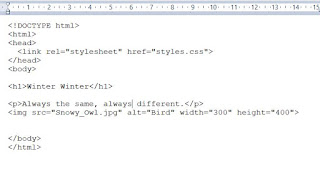to make sense to use Cascading Style Sheets. The idea is to keep all the
style information in one place, and have the visible body elements in
reference to them. The code is thus more economical and easier to change,
for oneself and others.
If the style info is internal to the html document, it will appear in the
head section. As an external document, the head will show a link to it.
Depending on the organization of things on a larger
project, reference can be made to a different URL, a page of the current web site,
the style section of the current page.
The link attribute within the head section is a very rich resource, that can specify and
link to elsewhere on the Web. No need to be a Silly Willy about political content on Social
Media; one can always require a link to the author( rel="author"), without involving the
innocent user in the issue...
rel="author" href="doxa-louise..." 😊
* * *
Here is an actual example. On my desktop, I have an html page (on Wordpad), an owl picture
(from Wikipedia) and a stylesheet (Wordpad) . I open the html page with Edge.
* * *
Margin is the distance between elements and the outside of the Web page. Padding -
like wearing a sweater - adds to the bulk of the text and pictures.






No comments:
Post a Comment